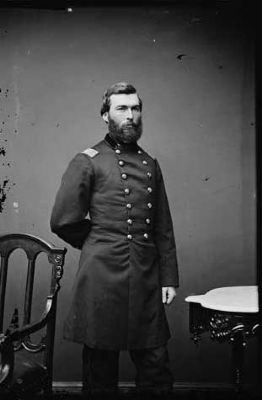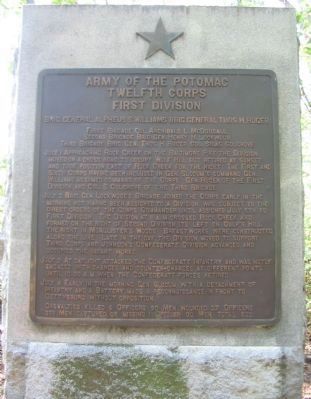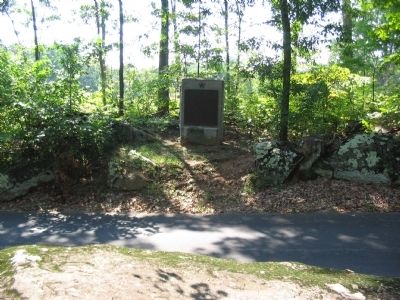Cumberland Township near Gettysburg in Adams County, Pennsylvania — The American Northeast (Mid-Atlantic)
First Division
Twelfth Corps
— Army of the Potomac —
Inscription.
Twelfth Corps
First Division
Brig. General Alpheus W. Williams, Brig. General Thos. M. Ruger
Fist Brigade Col. Archibald L. McDougall
Second Brigade Brig. Gen. Henry H. Lockwood
Third Brigade Brig. Gen. Thos. H. Ruger, Col. Silas Colgrove
July 1 Approaching Rock Creek on the Baltimore Pike the Division moved on a cross road to occupy Wolf Hill but retired at sunset and took position east of Rock Creek for the night. The First and Sixth Corps having been included in Gen. Slocum's command Gen. Williams assumed command of the Corps, Gen. Ruger of the First Division, and Col. S. Colgrove of the Third Brigade.
July 2 Brig. Gen. Lockwood's Brigade joined the Corps early in the morning not having been assigned to a Division was subject to the direct orders of the Corps Commander until assigned July 5th to First Division. The Division at 8 a.m. crossed Rock Creek and formed on the right of Second Division its left on Culp's Hill the right in McAllister's Woods. Breastworks were constructed along the line. Late in the day the Division moved to support Third Corps and Johnson's Confederate Division advanced and occupied the vacant works.
July 3 At daylight attacked the Confederate Infantry and was hotly engaged with charges and counter-charges at different points until 10.30 a.m. when the Confederate forces retired.
July 4 Early in the morning Gen. Slocum with a detachment of Infantry and a Battery made a reconnaissance in front to Gettysburg without opposition.
Casualties killed 5 officers 90 men. Wounded 27 officers 379 men. Captured or missing 1 officers 30 men. Total 533.
Erected 1910 by Gettysburg National Military Park Commission.
Topics. This historical marker is listed in this topic list: War, US Civil. A significant historical date for this entry is July 1, 1863.
Location. 39° 48.964′ N, 77° 13.087′ W. Marker is near Gettysburg, Pennsylvania, in Adams County. It is in Cumberland Township. Marker is on Slocum Avenue, on the left when traveling west. Located on the lower crest of Culp's Hill in Gettysburg National Military Park. Touch for map. Marker is in this post office area: Gettysburg PA 17325, United States of America. Touch for directions.
Other nearby markers. At least 8 other markers are within walking distance of this marker. First Brigade (a few steps from this marker); 20th Connecticut Volunteers (a few steps from this marker); 3d Maryland Infantry (within shouting distance of this marker); 5th Connecticut Infantry (within shouting distance of this marker); 29th Pennsylvania Infantry (within shouting distance of this marker); 123rd New York Infantry (within shouting distance of this marker); 2nd Maryland Infantry (within shouting distance of this marker); Twelfth Corps (within shouting distance of this marker). Touch for a list and map of all markers in Gettysburg.
Also see . . .
1. Culp's Hill. National Park Service virtual tour stop. (Submitted on November 20, 2008, by Craig Swain of Leesburg, Virginia.)
2. Report of Brig. Gen. Thomas H. Ruger. Gen. Ruger included a simple map of the area around Culp's Hill in his report. Of the action on July 2, he wrote:
The Twentieth Connecticut Volunteers, supported by the One hundred and seventh New York Volunteers, First Division, was thrown forward from the left of the division into the woods in rear of the stone wall held by the enemy. The general relation of the lines of the First and Second Divisions of the corps was a two-sided, truncated triangle, the apex at which point was the battery from the enemy, the ends toward the enemy inclining to the right and left, respectively, and too strong to be carried, Rocky Run protecting the right and strong breastworks occupying the left....
This state of things continued until about 10 a.m., the enemy maintaining the attack with great constancy,

3. General Thomas Ruger
Ruger graduated third in his class (1854) at West Point. He resigned and worked as a lawyer before the war. When war broke out, he became a Lt. Col. in the 3rd Wisconsin Infantry. During the war he commanded at Brigade and Division level. Remaining in the Army after the war, he retired a Major General in 1897, and died in 1907
(Library of Congress Collection, Call Number LC-B814- 1673)
(Library of Congress Collection, Call Number LC-B814- 1673)
Credits. This page was last revised on February 7, 2023. It was originally submitted on November 20, 2008, by Craig Swain of Leesburg, Virginia. This page has been viewed 858 times since then and 12 times this year. Photos: 1, 2, 3. submitted on November 20, 2008, by Craig Swain of Leesburg, Virginia.

